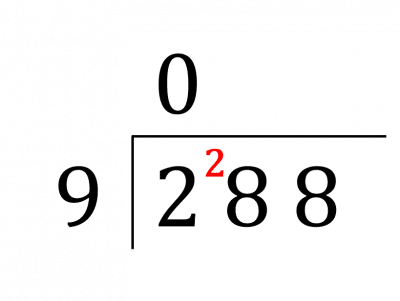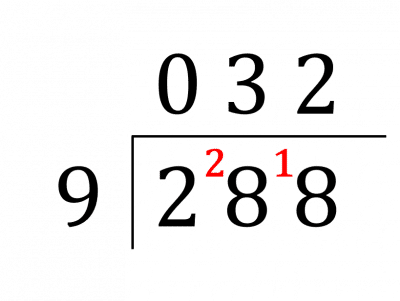Long Division – The Bus Stop Method
Long Division – The Bus Stop Method Revision
Long Division
There are different methods that can be used for long division but the most commonly used in the UK is the Bus Stop method.
Bus Stop Method
This method for long division is called the Bus Stop method, since it looks like a bus stop. This method allows us to divide numbers to find integer answers or answers that have a remainder. There are a few steps that you need to follow.
Example: Calculate 288 \div 9.
Step 1: We start by putting the division into the Bus Stop form as show below.

Step 2: We see how many times 9 goes into 2, the first digit. The answer is \textcolor{blue}{0} so the \textcolor{red}{2} is carried onto the next digit to make a new number, 28. The zero goes at the top.

Step 3: Now, we see how many times 9 goes into 28. We know that 3 \times 9=27, so 9 goes into 28 \textcolor{blue}{3} times with a remainder \textcolor{red}{1}, which is then carried in front of the next digit to make a new number, 18. The three goes at the top.
Step 4: Then, we see how many times the 9 goes into 18, which is \textcolor{blue}{2}. The two then goes at the top. These two steps are combined in the image below.

So,
288 \div 9 = \textcolor{limegreen}{32}
Note: If 9 did not go into the number in the last step, for example if the question asked to calculate 289 \div 9, then 9 goes into 19 \textcolor{blue}{2} times, with a remainder \textcolor{red}{1}. So we would say that the answer had a remainder of 1 and we would write
289 \div 9 = \textcolor{limegreen}{32} \text{ r } \textcolor{red}{1}
Example: Long Division with a Remainder
Calculate 67 \div 5
[2 marks]
We use the same bus stop method as shown before, but this time we have a remainder.

67 \div 5 = \textcolor{limegreen}{13} \text{ r } \textcolor{red}{2}
Long Division – The Bus Stop Method Example Questions
Question 1: Work out 315 \div 14.
[2 marks]
Here we’re going to use the bus stop method.
14 goes into 3 zero times, so we write a zero above the line and a small 3 – the remainder – in between the 3 and the 1. Then, we see how many times 14 goes into 31, writing the result above the line and the remainder just before the next digit of the dividend.
Repeat this process until you get the complete answer, which looks like,
\;\;\;\;\;0\;2\;2\;.\;5\\14\overline{\left)3{}^31{}^35.{}^70\right.}
Question 2: Calculate 225 \div 15.
[2 marks]
Here we’re going to use the bus stop method,
15 goes into 2 zero times, so we write a zero above the line and a small 2 – the remainder – in between the 2 and the 2. Then, we see how many times 15 goes into 22, which is 1, writing the result above the line and the remainder, 7, just before the next digit of the dividend.
Repeat this process until you get the complete answer, which looks like,
\;\;\;\;\;0\;1\;5\\15\overline{\left)2{}^22{}^75\right.}
Question 3: Calculate 4320 \div 160.
[2 marks]
Here we’re going to use the bus stop method,
160 goes into 4 zero times, so we write a zero above the line and a small 4 – the remainder – in between the 4 and the 3. Then, we see how many times 160 goes into 43, which is also zero, writing the result above the line and the remainder, 43, just before the next digit of the dividend.
Repeat this process until you get the complete answer, which looks like,
\;\;\;\;\;\;\;0\;\;0\;\;2\;\;7\\160\overline{\left)4{}^43{}^{43}2{}^{112}0\right.}
Question 4: Calculate 299 \div 13.
[2 marks]
Here we’re going to use the bus stop method,
13 goes into 2 zero times, so we write a zero above the line and a small 2 – the remainder – in between the 2 and the 9. Then, we see how many times 13 goes into 29, which is 2, writing the result above the line and the remainder, 3, just before the next digit of the dividend.
Repeat this process until you get the complete answer, which looks like,
\;\;\;\;0\;2\;3\\13\overline{\left)2{}^29{}^39\right.}
Question 5: Calculate 234 \div 9.
[2 marks]
Here we’re going to use the bus stop method,
9 goes into 2 zero times, so we write a zero above the line and a small 2 – the remainder – in between the 2 and the 3. Then, we see how many times 9 goes into 23, which is 2, writing the result above the line and the remainder, 5, just before the next digit of the dividend, so we find,
\;\;\;0\;2\;6\\9\overline{\left)2{}^23{}^54\right.}\\\;\;\;\;\;\;\;\;





